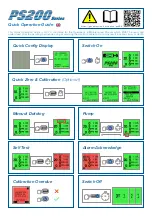
IST-47RTS282K
Istruzione / User’s Manual / Manuel d’utilisation
Pag.5/10
Comelit Group S.p.A
. - Via Don Arrigoni 5 - 24020 Rovetta S. Lorenzo BG Italy
Tel. +39 0346 750 011 - Fax +39 0346 71436
The 1
st
Red LED
(
ALARM 1
) illuminates when the Gas concentration attains 1st alarm level and after about 12
seconds, the “ALARM 1" relay will activate.
The 2
nd
Red LED
(
ALARM 2
) illuminates when the Gas concentration attains 2nd alarm level and after about 30
seconds, the “ALARM 2" relay will activate.
The 3
rd
Red LED
(
ALARM 3
) illuminates when the Gas concentration attains 3rd alarm level and after about 60
seconds, the “ALARM 3" relay will activate.
Faults
:
the instrument signal different kind of failures, as listed below. The Yellow LED illuminates, the "
S
" output
falls down to 0mA and the “
FAULT
”
normally activated relay deactivate. The "
FAULT
" relay, if necessary, can be used
both to signal remotely an occurred damage and to signal the absence of power to the instrument.
Yellow LED illuminates each 4 seconds (
with Green LED activate
):
this happens when the “
Cartridge Sensor
” has
overcome its period of life (about 5 years) and its correct operation is no longer guaranteed. The detector keeps on
operating normally but it is necessary to replace, as soon as possible, the “
Cartridge Sensor
” with a new one. The
type to be required is listed in 2
nd
column
Table 4
. The replacement procedure is described in the attached manual.
Yellow LED activates, Green LED off (
FAULT relays activate and 0mA output signal
):
this signal different kind of
faults.
1)
The Dip Switch set up is wrong, please verify (
see Table 2-3
).
2)
The “
Cartridge Sensor
” is not working,
please replace with new one.
3)
If a new
“
Cartridge Sensor
” is installed or it is not correctly connected or a not
compatible one is mounted. Please check the cartridge connections and compatibility (
see Table 4
) these checks are
made connecting and disconnecting the device.
If the condition does not change, it will be necessary to replace the
unit and/or send it back to the supplier to repair.
Yellow and Green LED activates (
FAULT relays activate and 0mA output signal
):
this happens when the “
Cartridge
Sensor
” is not working. First try to perform the procedure of “
ZERO
” as described in the section
“Test and Calibra-
tion > Zero adjust”
then disconnect and connect the unit, finally try to replace a new
“Cartridge Sensor
”. If the
condition is not change, it will be necessary to replace the unit and/or send it back to the supplier to repair.
All LED activate (
FAULT relays activate and >24mA output signal
):
this happens when the “
Cartridge Sensor
” is not
working or gas concentration is out of scale (higher than 25% LIE) If there are not any gas leaks and the condition
is not change, it will be necessary to replace the unit and/or send it back to the supplier to repair.
INSTALLATION
The detector must be accurately installed according to the national dispositions in force on the safety of the plants
and installation of electric devices in areas with danger of explosion.
Mounting
: The
Fig. 2
shows the instrument size. The unit must be positioned vertically with the sensor downwards.
Models 47RTS282KG
should be fixed at 20-30 cm from the floor (LPG and Petrol vapours are heavier than air).
Models 47RTS282KM
should be fixed at 20-30 cm from the ceiling (Methane and Hydrogen are lighter than air).
Models 47RTS282KI
should be fixed at 20-30 cm from the ceiling (Methane and Hydrogen are lighter than air).
Models 47RTS282KB
should be fixed at 20-30 cm from the floor (LPG and Petrol vapours are heavier than air).
Electrical Connection (
see Fig.2
)
: the maximum distance to install each detector from the power supply show in the
Table 1
. If more than one detector is to be powered in parallel, it is necessary to consider the voltage drop across
the supply cable. Normally use a two wire cable (
not shielded
) for power the conductors for output relay.
If
the output signal is used in mA, please use 3 conductors screened conductors for relay output. The max load
resistor is 50 ohm with 12Vdc (-10%) power supply, while is 500 ohm with 24Vdc (-10%) power supply (
see Fig.4
).
Power Supply terminals, on the main board, are plug-in type, it is necessary to extract them to make the connection.
Pay attention when you insert them again, being polarized. The relays terminals, on outputs board, are fixed.
The
sealed relays are
tension free
SPST (
S
ingle
P
ole
S
ingle
T
hrow)
contacts and should be set NO (Normally Open) or NC
(Normally Closed) by positioning the 4th Dip-Switch (
see Table 3
). With the
Dip-Switches from 1 to 3 the concentra-
tion for alarm activations is determined.
Note: Dip-Switch should be set with instrument powered off. Dip-Switch settled in reserved position acti-
vate Fault indications (
see “Operational Description > Faults”
).
Important
:
Once installation is completed,
power up the unit,
wait about 20÷30 minutes and then,
only if it is
necessary
,
to adjust the sensor to the environment conditions,
carry out the
Zero Adjust
(
see
Test and Calibration
)
.
WARNING
Average life
: The sensitive element used in this detector has an excellent stability in time. In fresh air and in nor-
mal working condition the sensor's life is about 5 years from the date of installation. After this period the yellow LED
“
FAULT
” flashes every 4 seconds, is necessary replacing the “
Cartridge Sensor
”.
Periodical testing
: we advise to carry out working tests every 12 months. Tests, Zero Adjust and Calibration with
Gas/Air mixture as explained on
page 4
chapter “
Tests and Calibration
”.
Note:
the detector is not able to detect gas leaks occurring outside the room where it is installed, neither inside
walls nor under the floor.
Important:
The catalytic sensor operates only in presence of Oxygen. Do not use pure gases or a lighter directly
on the sensor since they could damage it irremediably.
Warning:
some substances cause a permanent reduction in sensitivity. Avoid contacts of the sensor with vapours
of Silicone compounds, Tetra-ethyl Lead (petrol antiknock additive) and Phosphate esters, since they can reduce
irremediably its sensitivity. Some substances produce a temporary loss of sensitivity. This “inhibitors” include Hy-
drogen sulphides, Chlorine, Chlorinated hydrocarbons and halogenated compounds. The sensitivity is recovered
after a short period of running in clear air.




























